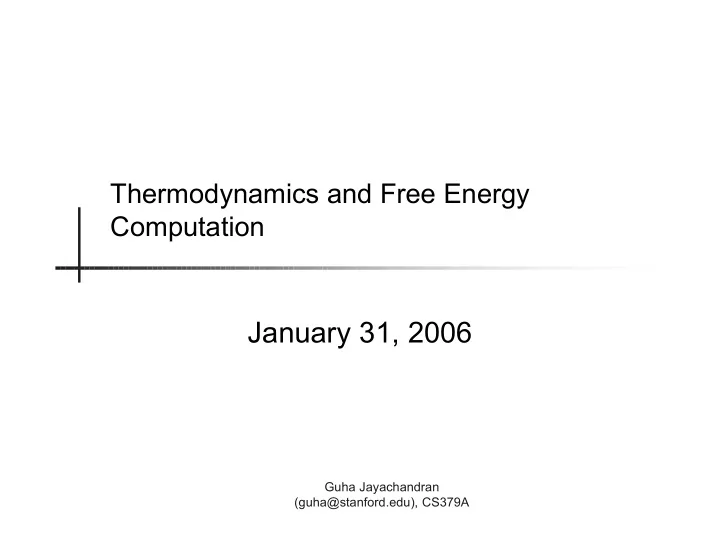

Thermodynamics and Free Energy Computation January 31, 2006 Guha Jayachandran (guha@stanford.edu), CS379A
Laws of Thermodynamics Energy is conserved. 1. Entropy increases on average. 2. Entropy goes to a constant as 3. temperature goes to absolute zero.
Internal Energy In molecular mechanics, sum of the molecular mechanics energy terms (bond energy, electrostatic energies, etc.) Enthalpy: H = U + PV ∆ H = ∆ U + P ∆ V If we do work on a system, we increase its energy (First Law says energy’s conserved)
Entropy Be free, get mixed up Higher entropy outside partition than inside When binding, a ligand loses entropy
Free Energy ∆ F = ∆ E - T ∆ S Lower enthalpy gives lower ∆ F Higher entropy gives lower ∆ F State function (pathway independent) Means we can break process into steps Significance follows from 2nd Law: ∆ Q / T ≤ ∆ S ∆ Q ≤ T ∆ S ∆ E - ∆ W ≤ T ∆ S (using 1st Law) ∆ E - T ∆ S ≤ 0 (if ∆ W=0) ∆ F ≤ 0 More negative means more favorable
Boltzmann Distribution All systems have some equilibrium distribution of states Boltzmann factor, exp(- E / KT ), gives relative probability Molecular dynamics, if it’s accurate, will clearly sample with equilibrium probabilities if given enough time Note it’s ergodic also Are there other ways?
Monte Carlo Simulation Many applications outside molecular simulation <- Integrate Steps in Metropolis Monte Carlo Propose change in conformation from move set (how generate?) Compute proposed conformation’s energy. If it’s lower than current conformation’s, accept it. If not, accept with Boltzmann probability e – ∆ E/kT . Repeat.
M.D. vs. Monte Carlo M.D. Monte Carlo Have time Yes No coordinate Need move set No Yes Can make No Yes large moves Yields Yes Yes equilibrium distribution Kinetic energy Yes No contribution Memoryless No Yes
Common Free Energies Solvation free energy Free energy change associated with putting a given molecule in solvent Binding free energy Free energy difference between bound and unbound states for a given protein/ligand pair
Free Energy Computation Approaches Variety of formulations; many can be expressed as finding the equilibrium free energy from nonequilibrium work distributions Thermodynamic integration Slow growth Free energy perturbation Sampling method Absolute vs. relative free energy Are we computing something that can be measured directly, or are we computing a ∆∆ G? Model
Free Energy Perturbation In FEP, estimate equilibrium ∆ F from nonequilibrium work distributions by exponentially averaging potential energy differences between a reference state sampled at equilibrium and a target state 0 ∆ U ∆ U ∆ U ∆ U ∆ U ∆ U 1 ∆ F 0->1 = -(1/ß) ln <e -ß ∆ U >
Absolute Binding Free Energy Compute free energy difference stepwise between P in water (with L (g) ) and P:L in water Gas only interacts with itself Gradually turn on interaction between L and rest of system ∆ G 0-1 ∆ G 1-2 ∆ G 2-3 … L P P:L … λ =0 λ =0.1 λ =0.2 Compute difference between L (g) and L (aq) stepwise P (aq) + L (g) → P:L (aq) (coupling energy) + L (aq) → L (g) (ligand desolvation energy) L (aq) + P (aq) → P:L (aq) (binding energy)
Thermodynamic Cycles Relative free energy ( ∆∆ G) may need less computation and probably benefits from cancellation of errors Do unnatural “alchemy,” turning one ligand into another Do this by defining end states as indicated below We again take advantage of fact that free energy is a state function (consider the two paths from P+L1 to P:L2) P+L1 P:L1 P+L2 P:L2 ∆ G(P+L2->P:L2) - ∆ G(P+L1->P:L1) = ∆ G(P:L1->P:L2) - ∆ G(P+L1->P+L2)
MM/PBSA Poisson Boltzmann (PB) Treat solute as medium of constant low dielectric (2-4) and solvent as medium of high dielectric Poisson equation yields variation in potential given charge density and dielectric Taking into account ion effects gives Poisson-Boltzmann equation Solved numerically Combine molecular mechanics with PB Collect structures with M.D. or Monte Carlo Calculate electrostatic contribution to the solvation free energy with PB (or GB) on those structures Use a solvent accessible surface area (SA) term to account for hydrophobic contribution Not too accurate for absolute free energies
Challenges for Free Energy Computation Sampling How do you sample the space? How do you know you’ve sampled the space? Model and force field parameters Need quantum mechanics? But then sampling slower. Experimental comparison Often a K i is measured and we assume it’s equal to K d Experiments have error too
Readings Hierarchical Database Screenings for HIV-1 RT Using a Pharmacophore Model, Rigid Docking, Solvation Docking, and MM-PB/SA (Junmei Wang, et. al., J. Med. Chem.) Glycogen phosphorylase inhibitors: A free energy perturbation analysis of glucopyranose spirohydantoin analogues (Archontis, et. al., Proteins) Ion Solvation Thermodynamics from Simulation with a Polarizable Force Field (Grossfield, et. al., JACS) Stochastic roadmap simulation for the study of ligand-protein interactions (Apaydin, et. al., Bioinformatics)
Recommend
More recommend